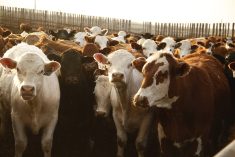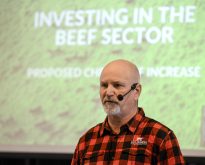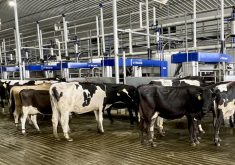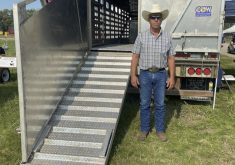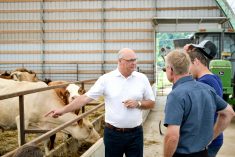The dates are seared in Dennis Laycraft’s brain: May 20, 2003, when the first positive-testing cow was confirmed; August 10, 2003, when the U.S. and Mexico restored import access for Canadian boneless beef from animals under 30 months of age; July 14, 2005, when the U.S. reopened full access for all Canadian beef, both live and processed.
Laycraft, executive vice-president of the Canadian Cattle Association, spoke to Farmtario recently about the upcoming 20th anniversary of the discovery of classic-variant bovine spongiform encephalopathy (BSE or “mad cow disease”) in an Alberta-born cow on a Saskatchewan ranch.
Why it matters: Opportunities continue to grow, both domestically and internationally, for sustainably produced Canadian beef, and the lessons learned through the BSE outbreak will hopefully safeguard the sector from experiencing anything similar in the future.
Read Also
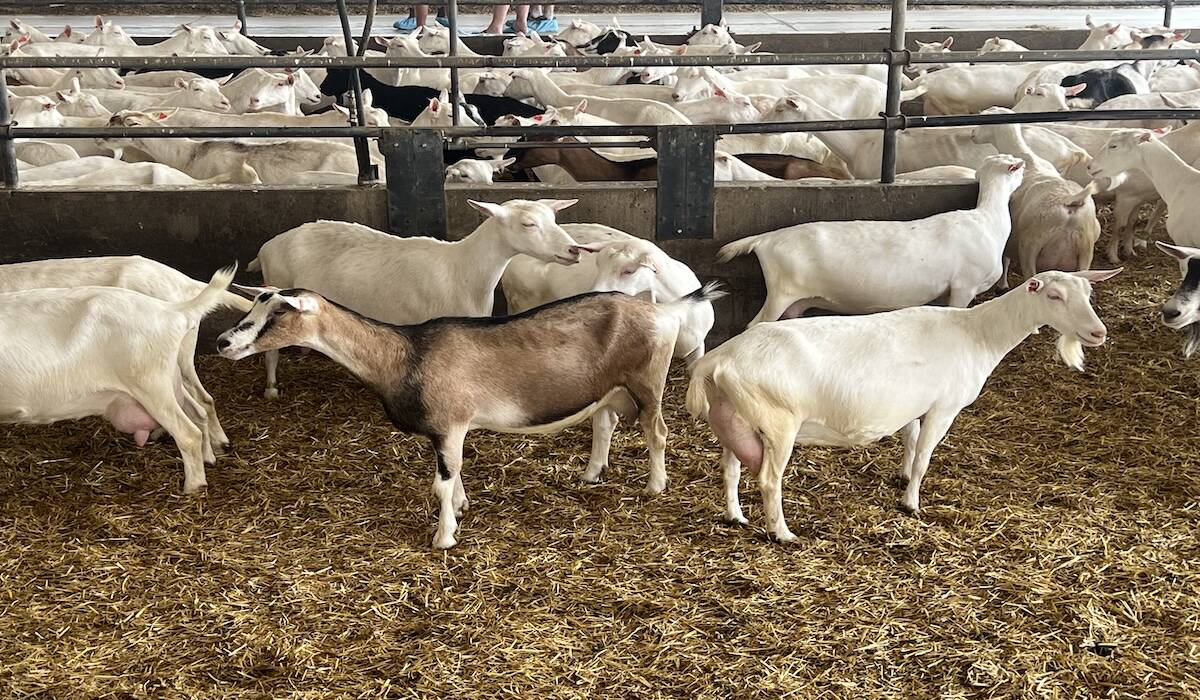
Ontario dairy goat producers move toward forming provincial board
Creation of a Dairy Goat Board under the Ontario Farm Products Marketing Commission may be voted on by early 2026.
Spurred by BSE’s links to the fatal human Creutzfeldt-Jakob Disease and BSE’s own significant threat to the North American beef herd, the discovery almost immediately led to a complete shutdown of export markets for Canadian beef.
On March 27, the federal government announced the removal of one final restriction on beef exports to Japan, celebrating the coming into force of a previously agreed-upon deal in a news release as “usher(ing) in a new era for Canada and its second-largest market for beef and beef products: expanding market access for Canadian exporters while also benefiting Japanese consumers who will have greater access to Canada’s high-quality beef products.”
In beef-producing regions near and far from Ottawa, however, the anniversary of BSE’s emergence will see the industry reflect on an era they would rather forget.
“We basically almost lost a generation of beef producers,” said Laycraft. The paralysis of the sector in BSE’s wake forced many to rethink their plans, sell or depopulate their herds, and exit the industry. An Alberta-born-and-raised beef farm native who has been in his current post since 1992, Laycraft likened BSE’s effects to oil sector boom-and-bust cycles of investment, loss and consolidation.
“Those farmers or ranchers with more equity ended up acquiring those with less equity who couldn’t weather the storm.”
The number of beef herds with 200 head or less steeply contracted, and now a much greater proportion of western Canadian cattle herds number 1,000 or more.
Pasture, and particularly native grasslands, also took a huge hit. Many tens of thousands of western Canadian acres were converted to cropland. The effects of that transformation on soil health and climate change mitigation are only now being acknowledged.
In Ontario, comparing the ratio of pasture to cropland in regions like Grey-Bruce from 2003 to now confirms a similar soil health-threatening transformation unfolded.
Laycraft used the word “paralysis” on multiple occasions when recalling the 2003 events. He remembers May 20 very well. He was on the way back to Calgary after attending an Edmonton press conference alongside then Canadian Cattlemen’s Association president, the late Neil Jahnke, when he learned that U.S. Agriculture Secretary Ann Veneman had told a media gathering that the U.S. had full confidence in the Canadian beef supply.
Nonetheless, within hours, the U.S. border closed to Canadian cattle and beef.
Canada decided to suspend export permits, which prompted almost all countries in the world to ban imports from Canada.
“There were a couple of fringe markets that stayed open and were there when export permits resumed but they were not substantial importers of Canadian beef,” said Laycraft.
All activity in the Canadian sector shut down. Processors cut back their purchases and producers were forced to implement strategies to keep cattle longer on their farms halt any herd expansion.
At the time, knowledge about BSE was still developing. By 2014, countries in Europe were confident that they had protocols in place to identify and contain BSE, so they called off further research into the disease. Even by 2007, there was a strong level of confidence globally that if protocols were followed, the disease could be effectively contained.
That year, Canada was declared by the World Organization for Animal Health as a “negligible risk country” for BSE, prompting numerous countries to begin discussions with Canada for resumed beef imports.
But back in 2003, Canada relied on established knowledge about animal disease containment and human food safety to implement a BSE strategy. Looking back, Laycraft recognizes how impressively that unfolded.
“It was by far the most comprehensive and transparent investigation of BSE that had ever been conducted anywhere in the world,” he said. There was also a close working relationship with the U.S. counterpart to the Canadian Food Inspection Agency, and this set the stage for what now can be recognized as a surprisingly rapid resumption of trade in some products to the U.S. and Mexico.
Laycraft also had high praise for supporters across Canada, both inside and outside the beef sector. He credited this support to the ability of the government and industry leaders to assure the Canadian public that biosecurity measures already in place before BSE had effectively contained its spread and that an effective strategy was being implemented after the discovery to insure the food supply remained safe.
“You started to see BBQs from one end of the country to the other,” he recalled, including “some huge BBQs put on for the public by various supporters of the industry. … By Father’s Day (2003) we actually had a shortage of beef because Canadians were so eager to help the farmers.”
Compared to July 2002, beef consumption in July 2003 in Canada jumped by 70 per cent. People ate more beef as a show of support for Canadian farmers, and the paralysis at the processing level eased considerably. This happened while consumption in some other countries affected by the BSE outbreak saw beef consumption plummet by as much as 90 per cent.
By 2005, processing capacity in Canada outstripped levels in May 2003.
Laycraft didn’t know it at the time but, given the obvious enthusiasm for beef farming in Canada, BSE marked the beginning of what he called “a perfect storm decade” for the sector. Through 2005-06, a historically high loonie significantly impacted prices for a sector heavily linked to the U.S. market. The 2007 hike in energy prices caused farm-level challenges and in 2008 “the great recession” took hold around the world.
Among those challenges, at least with BSE, there was significant financial assistance from the federal government to those remaining in the beef sector.
“We were pretty happy to see 2010 come along and hopefully start out a new decade,” said Laycraft
Regarding the recent March announcement, Laycraft agreed that access to further-processed beef is “kind of the last little piece that’s left in Japan.” A few countries in the same region as Japan have “relic restrictions,” including South Korea and Taiwan, he conceded, but these restrictions affect Canada as well as the U.S.
Laycraft said the remaining restrictions “speak more, I think, to the long time it can take for these things to work their way through the various steps to approval.”
It has taken a long time, too, for the positive repercussions of Canada’s brush with BSE to become apparent. But Laycraft said there have been some.
“One thing we became (as a result of the BSE trade restrictions) was one of the most efficient cattle production areas in the world,” he said.
Resources, both from governments and from the industry, were devoted to research and innovation into producing high-quality beef in a feed-efficient manner that could demand a premium price internationally.
“We became a leader in sustainability. Survival tends to make that happen.”
In 2012, the McDonald’s restaurant chain used the Canadian model to create a pilot project into sustainably raised beef.
Japan reopened for imports of Canadian bone-in beef from cattle 20 months of age or younger in 2005, to bone-in beef from cattle 30 months or younger in 2013, and to bone-in beef from cattle over 30 months in 2019.
From an Ontario perspective, the removal of these bone-in restrictions was significantly more important than the recent easing on further-processed beef, says the director of the Ontario Beef Development Program.
John Baker said Ontario’s fed cattle are typically marketed below 30 months of age and the beef is often destined for premium-quality markets that yield a higher price per kilogram. As a result, Ontario represents about 25 per cent of Canada’s total beef exports to Japan but represents 50 per cent of exports in the chilled market, “and Ontario Corn Fed Beef is by far the largest-selling brand of Canadian beef in Japan.”
Since being introduced into Japan in 2015, the brand has seen a 200 per cent increase in sales by volume and a 300 per cent increase in sales by value, he said.
Baker, who was part of a recent trade mission to Japan and Vietnam led by Ontario Minister of Agriculture, Food and Rural Affairs Lisa Thompson, says Malaysia and Indonesia are two other nations where he would like to see BSE-era beef restrictions lifted.
But by and large, he believes there’s reason to celebrate the recent Japan trade reopening announcement. With Canada enjoying a huge competitive advantage over U.S. beef producers in the region due to the U.S. government’s unwillingness to join the Comprehensive and Progressive Agreement for Trans-Pacific Partnership, there’s optimism about growth for Canadian and Ontario beef.







